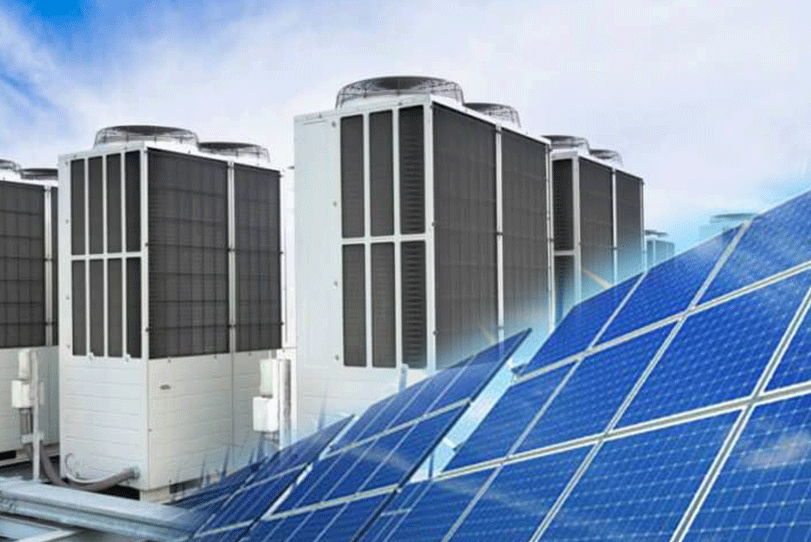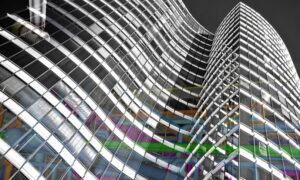Solar-powered cooling refers to a system that converts heat from the Sun into cooling that can be used for refrigeration and air conditioning. This is a sustainable means of cooling that uses different principals and functioning.
Solar power and India
In March 2019, Government of India had launched India Cooling Action Plan (ICAP), keeping the fast developing industry in view with a time horizon of almost 20 years which enlists the action plan which will help in reducing refrigerant transition, cooling demand, enhancing energy efficiency and better technology options across sectors. Initially, India had a target of 20GW capacity for 2022, which was achieved 4 years ahead of schedule. If we look at the current market, the cooling demand is set to rise in future in our country as it is a cross sectoral growth and an essential part for economic growth. A major part of cooling demand depends of refrigeration based cooling across different sectors like buildings, refrigeration, cold-chain, transport. According to the International Energy Agency (IEA), refrigeration and air conditioning (RAC) causes 10 percent of the global CO2 emissions. As per the data available in the public domain, India has the lowest accesses to cooling across the world, which also reflects in its low per capita levels of energy consumption for space cooling which is at 69 kWh, as compared to the world average of 272 kWh.
Changing consumer market
If we talk about the dynamic Indian consumer market, the air conditioning industry in India is growing at a rapid rate and that is directly proportional to rise in middle-class population, rising number of houses and buildings. To make it an environment-friendly market, solar-powered cooling solutions can be an effective means, but that again calls for revamping the market, which is going to be a tedious process.
Cooling challenges
According to the World Health Organization by 2050, more than 255,000 people would die of extreme heat waves annually. And if go by the statistics, of the 2.8 billion people living in the hottest parts of the world, only 8 percent have air conditioners (ACs). It has been reported that access to comfort cooling is critical for many communities around the world and deploying entry-level air conditioners, which typically consumes a lot of energy and could possibly be one of the largest end-use risks to our climatic conditions. As per statistics, the direct and indirect emissions from room ACs could contribute to as much as a 0.5 degree Celsius increase in global warming by 2100.
Impact on climate
It’s a vicious circle, where AC units impact our health and climate at large. While India contributes only 5 percent of the global annual emissions from room ACs at present, in the corporate world, India is predicted to account for over 25 percent of annual emissions globally by 2050 due to the unprecedented rise in comfort cooling demand, particularly in the residential sector.
Averting the energy crisis
It’s high time and Government’s intervention is the only solution to handle the situation. If we look at the current scenario, government, at both the federal and state levels have been exercising political action and that has resulted in Ahmedabad being the first city in South Asia to develop a heat action plan after a distressing heat wave hit the city in 2010. And in 2019, India became the first major country in the world to develop a national policy document on cooling, the India Cooling Action Plan.
What’s the solution?
To promote the adoption of more energy-efficient ACs, the Bureau of Energy Efficiency has defined the minimum energy performance standards for ACs and has been raising this efficiency performance requirement at nearly 3 percent every year. In the same league, it has also developed a star label system to help raise consumers’ awareness about room AC efficiency. In addition, the Government of India’s energy services conglomerate, Energy Efficiency Services Limited (EESL), which was created in 2009 as a joint venture of four national public-sector undertakings, is looking to aggregate demand for superefficient room ACs leveraging economies of scale to bring first costs closer to those of the standard-efficiency ACs being sold in the market today.
Why solar-powered cooling is beneficial?
Solar power is a clean and green source of energy which is the best way to reduce carbon footprints. Also, it is a great contributor to sustainable future. The sun provides us additional energy than we could ever use, and nobody can control the sunlight. The benefits of solar power are best visible in the long-term. Solar powered cooling do not produce air pollution or greenhouse gases. The biggest benefit of solar powered cooling is that they offer cost savings. This is an era where many people are adopting eco-friendly items. The consumers, especially industrial and commercial, are keen to make capital investments to contribute towards the preservation of the environment. Environment-friendly consumers are even ready to pay higher than grid power. Solar air conditioning units offer environmental benefits which includes lower grid demand and load shifting during peak usage, reduced electricity costs, fewer power outages, off-the-grid capabilities and reduced greenhouse gas emissions.
What’s more
Taking the lead, EESL has recently announced that they are partnering with BSES, a utility in Delhi, for a 12-month pilot program that will look at deploying ACs that are 40 percent more efficient and are priced comparably to the three-star ACs. As per the report, the pilot program would cater to around 2.5 million residential and institutional consumers in Delhi and around.
Authored by:
Ms. Monika Singh, Director, Exalta
Cookie Consent
We use cookies to personalize your experience. By continuing to visit this website you agree to our Terms & Conditions, Privacy Policy and Cookie Policy.

















